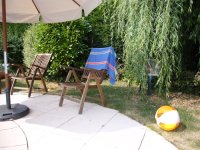I have not spent a lot of time testing and working out technical perspective problems, etc.. What I did do was fairly complicated archaeological photography in the desert in the Middle East under severe conditions, using, at the start, F4s, then a combintion of F5s and N90s, then D1x, then D2x, and in between the last two, a couple of Kodak SLRns. They were used to do on-site shots under a wide range of field conditions, ranging from pre-dawn light to stuff shot at high noon (in archaeology, you often don't have a choice; when you shoot depends on when an object comes up.) I also shot publicity photos for brochures and magazines; still life museum-type artificially lit shots of collections of pots and other artifacts; and macros of very small objects down to little-fingernail size (beads.)
I could have cared less about the digital/film argument, except that digital made life much easier; for one thing, you could verify on-site that you actually had the shot, which is important in archaeology, because then you can remove the object from its context and continue working.
Now, to relate that experience to this thread, I never paid too much attention to the change-over from "full-format" film to Nikon's 1.5 crop, although I did have to go out and buy a shorter lens. That was about it. I published a number of full-color photos in Bibilical Archaeology Review, including a double-truck that was actually a cropped shot (cropped down from the 1.5 sensor size), and it looked fine. At the very largest fine-art sizes, maybe a 5D or 1DsII would be marginally better than a D2x, but I have my doubts; at that point, the photos (I think) are becoming more lens-limited than sensor-limited. To put it another way, a Leica 10mp with the best 50mm Leica lens may take better photos than a Canon 16mp, because the lens makes more difference than the sensor. (And I suspect that at the larger fine-art sizes, a MF back would be even better, so if you really worry about this, maybe you should be shooting one of those.)
One thing that I really could have used on site was faster lenses. A summilux would have been a gift from the gods when you're trying to shoot into a hole in the ground in early pre-dawn light. But the format made no difference at all. Zip. Zero. I'd been shooting 35mm film for 40 years, since I went to Venezuela and Colombia as a kid in 1961; I had no trouble in the transition; it was the last thing that I would have thought of as troubling.
I also found a few really interesting things about the small format, like being able to ditch anything longer than a 200, because a 200's angle-of-view gave me a functional 300 with much less weight AND faster speeds AND lower cost -- which is important when you're working in a big pile of dust and sand and you have to change equipment every three or four years.
My feeling about a lot of these format arguments is essentially the same as the guy who suggested that there's a big PR element involved. On a practical level, FF or small frame (up to a point) just doesn't make much difference. I'm a professional writer, and in my experience, changing from FF to 1.5 was like changing my keyboard. I notice, but adaption comes quickly and then I don't notice anymore. The end product doesn't change at all.
JC


